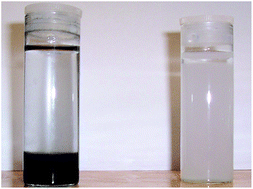Batch and continuous phosphate uptake studies employing a ferrimagnetic calcium silicate hydrate composite†
Abstract
Composite particles of ferrimagnetic magnetite and a nano-structured calcium silicate hydrate were synthesized and used for the sorption of phosphate from solution. The composite was very effective achieving phosphate uptakes of up to 5.5 mmol phosphate per gram of composite. The amount of phosphate sorbed depended on the ratio of silicate to magnetite in the composite as the silicate component was proven to be far more effective in the uptake than the iron oxide component. Although no definitive distinction was possible the uptake of phosphate appeared to follow second order kinetics and a Freundlich isotherm model. Continuous uptake studies were carried out which showed the importance of controlling the flow rate of liquid through a column containing the sorbent. While the attractive magnetic force kept the sorbent together for lower flow rates, at a high flow of feed solution sorbent material was lost into solution. The continuous uptake studies indicated furthermore that agglomeration limits the number of available active sorption sites and hence the effectiveness of the composite.


 Please wait while we load your content...
Please wait while we load your content...